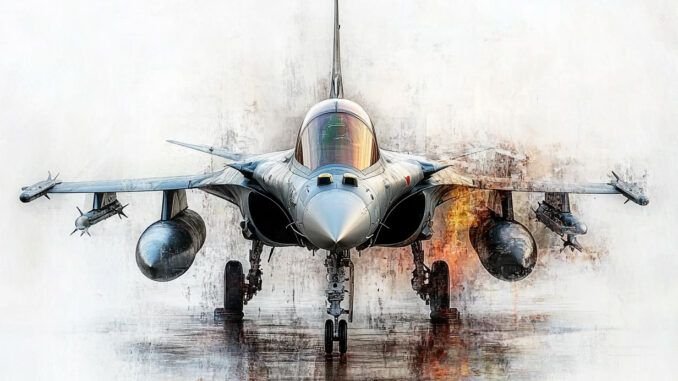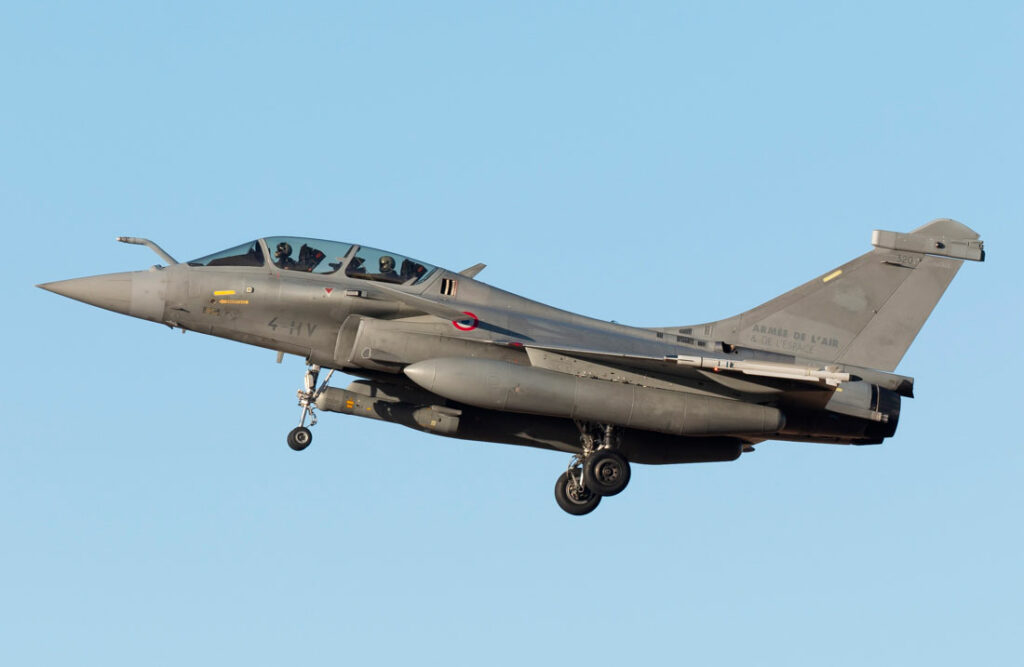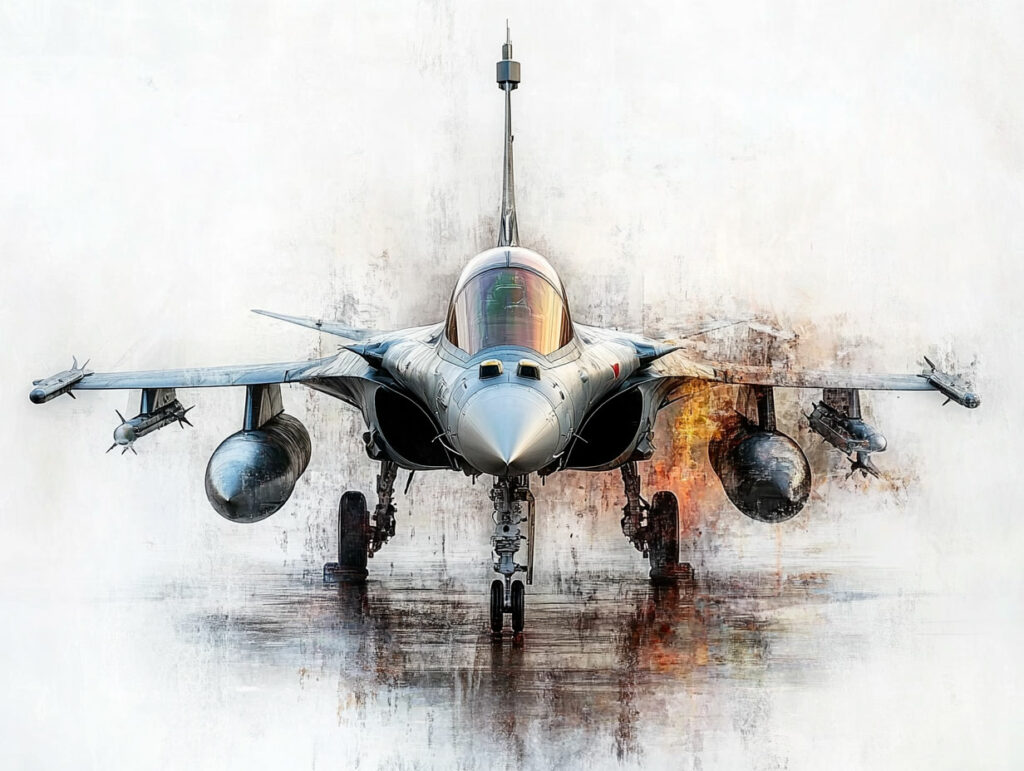
France is investing 1.5 billion euros to equip Luxeuil Air Base 116 with 40 Rafale F5s armed with ASN4G hypersonic nuclear missiles by 2035.
Air base 116 in Luxeuil, located in eastern France, will be reactivated to accommodate two squadrons of 40 Rafale F5s armed with ASN4G hypersonic nuclear missiles by 2035. This project, announced by President Emmanuel Macron, represents an investment of 1.5 billion euros. It is part of a strategy aimed at strengthening French nuclear deterrence autonomously, while addressing security concerns in Europe. This initiative marks a significant evolution in France’s strategic posture, particularly in the context of current geopolitical tensions.
Reactivation of Luxeuil Air Base 116: a major strategic investment
Luxeuil-Saint Sauveur airbase 116, located in the department of Haute-Saône, has been selected to host two F5 Rafale squadrons, or 40 aircraft, armed with ASN4G hypersonic nuclear missiles. This project represents an investment of 1.5 billion euros and aims to strengthen French nuclear deterrence.
Currently, the base is home to the 1/2 Cigognes fighter squadron, equipped with Mirage 2000-5Fs, which will be gradually withdrawn from service by 2029. Some of these aircraft could be transferred to Ukraine as part of French military aid. The first Rafale F5 squadron is scheduled for 2032, with full operational capacity in 2033, followed by the second in 2036.
The reactivation of Luxeuil as a nuclear base is part of a broader strategy to modernize the French armed forces, aimed at strengthening the deterrent posture against emerging threats.

The Rafale F5: a technological evolution for nuclear deterrence
The Rafale F5 represents a significant evolution of the multirole fighter from Dassault Aviation. Designed to remain in service until 2060, it incorporates notable improvements:
- Human-machine collaboration capability: integration of “loyal wingman” drones for swarm missions.
- Reduction of the radar signature: addition of conformal tanks and radar cross-section reduction kits to improve stealth.
- Compatibility with the ASN4G missile: integration of the new hypersonic missile to strengthen nuclear strike capability.
These improvements aim to maintain the technological superiority of the Rafale against modern threats, particularly in contested environments.
ASN4G: the hypersonic missile at the heart of nuclear modernization
The ASN4G (4th Generation Nuclear Air-to-Surface) missile is being developed to replace the ASMP-A. Its expected characteristics are as follows:
- Speed: Mach 6 to 7, or approximately 7,400 to 8,600 km/h.
- Range: more than 1,000 km, double that of the ASMP-A.
- Payload: 300 kiloton air-delivered nuclear warhead (ADNW).
The development of the ASN4G is being carried out by MBDA and ONERA, with commissioning scheduled for 2035. This missile will strengthen France’s deep strike capability, while improving the penetration of enemy defenses thanks to its increased speed and stealth.
Towards European nuclear deterrence under French leadership?
The reactivation of Luxeuil is part of a context of reflection on European nuclear deterrence. President Macron has raised the idea of a “strategic dialogue” with European countries that do not have nuclear weapons, suggesting a possible extension of French deterrence.
However, this proposal is sparking debate. Some countries, such as Germany, remain committed to the protection offered by NATO and the United States. Moreover, French doctrine emphasizes the strictly national character of deterrence, which complicates pooling at the European level.
Nevertheless, in a context of heightened geopolitical tensions, France could play a central role by offering a guarantee of nuclear security to European countries, thus strengthening its strategic position on the continent.
Geopolitical and strategic consequences of the modernization of Luxeuil
The modernization of the Luxeuil base will have several implications:
- Strengthening of the French deterrent posture: increase in the number of available aircraft and missiles.
- Strategic message at the international level: affirmation of France’s strategic autonomy in relation to the major powers.
- Impact on the European dynamic: possibility of redefining the security balances in Europe, particularly in the event of a partial withdrawal of American involvement.
By investing in the modernization of Luxeuil, France is strengthening its ability to act independently while offering a potential security guarantee to its European partners.
French suasion. It reinforces the credibility of the national nuclear posture, while laying the foundations for an expanded role in European security. This project also illustrates the rise of hypersonic and autonomous technologies in contemporary military strategies.
Asserted strategic autonomy in an uncertain NATO framework
Since the 1960s, France has deliberately developed an autonomous nuclear deterrent, independent of NATO’s integrated command, which it reintegrated in 2009. Unlike the United Kingdom, whose nuclear component is based on American Trident missiles, France designs, produces and maintains its nuclear weapons entirely, whether it be the M51 missiles for the Navy or the ASMP-A (soon to be ASN4G) missiles for the Air and Space Force.
This independent positioning gives it a strategic flexibility that is unique in Europe. In the current context of the American commitment in Europe being called into question – particularly as a result of Donald Trump’s statements that NATO support is conditional on Member States’ defense spending – France is the only nuclear power in the EU. This reality gives Paris increased weight in European strategic discussions, at a time when some partners such as Germany are calling for a rethink of the continent’s nuclear protection.
The strengthening of Luxeuil is therefore part of a strategy of European strategic autonomy, without reneging on NATO commitments, but by building a national capacity capable of compensating for a possible transatlantic flaw. It should be noted that this strategy remains politically sensitive: public opinion in France and Europe remains divided on the relevance of a mutualized nuclear defense, especially without a clear democratic control mechanism.

The industrial and technological implications of the Rafale F5 program
The Rafale F5 program represents a major industrial challenge for the French aeronautics industry. It mobilizes the skills of Dassault Aviation, Thales, Safran, MBDA and ONERA, an ecosystem that directly and indirectly employs more than 100,000 people. According to projections by the Ministry of the Armed Forces, the development phase of the F5 standard between 2026 and 2030 should generate several hundred million euros in annual orders, both in R&D and in production.
Technologies under development include:
- A new Thales electronic scanning radar with wide bandwidth, improved for low signature detection.
- A new M88 engine from Safran, optimized for extended performance at high altitude and with better thermal efficiency.
- Cross-platform data fusion capabilities, enabling the Rafale F5 to act in coordination with drones, satellites and other aircraft via a combat cloud.
These innovations should also benefit exports, an area in which the Rafale is booming: 211 units have been ordered internationally since 2015, for an estimated total of more than 30 billion euros. The F5 standard could be of particular interest to the United Arab Emirates, India, Egypt and Greece, which are seeking to integrate collaborative and stealth combat capabilities into their fleets.
A strategy of territorial presence and reindustrialization
The investment in Luxeuil is also part of a military territorial network strategy. The Luxeuil base was threatened with closure in 2008. Its maintenance and subsequent modernization contribute to the structuring of the local economic fabric in the Haute-Saône department.
The base currently employs around 900 military and civilian personnel. With the arrival of the Rafale F5, this number could rise to 1,300 to 1,500 people, not to mention the indirect impact on the local economy (housing, subcontracting, shops).
The modernization of the base (hangars, runways, nuclear safety infrastructure) will begin in 2026 and will continue until 2031. The total investment of 1.5 billion euros, financed by the Military Programming Law 2024–2030, contributes to local reindustrialization within the broader framework of the France 2030 plan.
This dynamic is part of a general policy of strengthening French strategic air bases (Istres, Avord, Saint-Dizier), which are considered to be the logistical and operational hubs of deterrence and external operations (OPEX).
Defense outlook and nuclear doctrine until 2060
With the expected entry into service of the Rafale F5 between 2032 and 2036, France is preparing the next generation of airborne nuclear doctrine until 2060. The announced format suggests a desire to maintain a robust airborne deterrent, in addition to the oceanic deterrent provided by the Le Triomphant class nuclear-powered ballistic missile submarines (SSBNs).
The current doctrine is based on the ability to inflict “unacceptable” damage on a state adversary in the event of a major attack. The development of hypersonic missiles, which are difficult to intercept, improves the credibility of this threat. The ASN4G missile, capable of traveling 1,000 km in 7 minutes at Mach 6, makes interception almost impossible with current air defense technologies.
In addition, the growing interoperability with drones, satellites and electronic warfare systems allows the Rafale F5 to integrate into a highly digital combat ecosystem, which makes any massive attack against France much more complex to plan and execute.
War Wings Daily is an independant magazine.